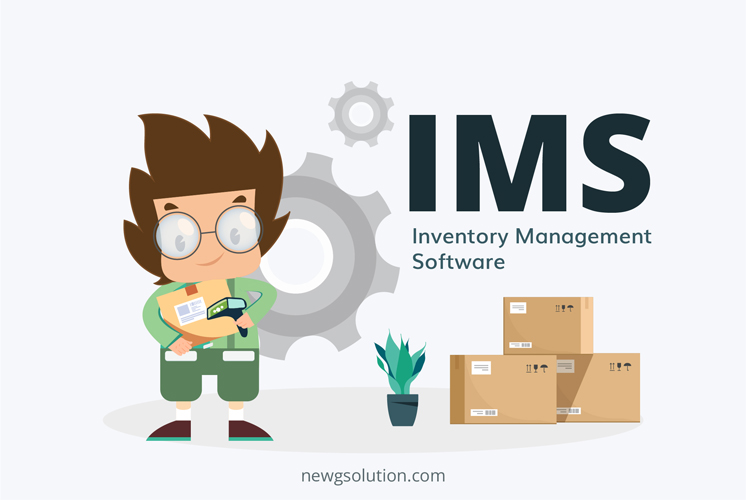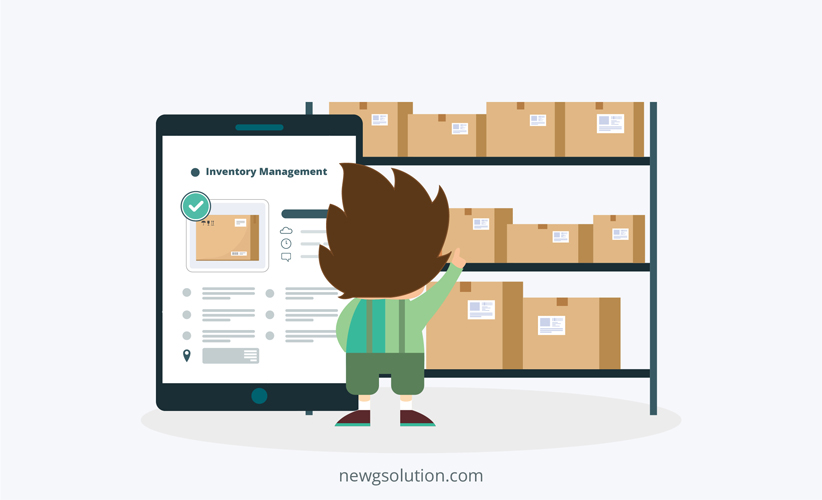Your Full Guide to Inventory Management Software
Inventory Management
LAST UPDATE: MAY 12, 2023
10 minutes reading
Inventory management software makes sure that your company’s inventory is maintained at the right levels. But what characteristics should you consider while selecting the ideal software for your company?
It might be difficult to manage inventory when there is a scarcity of one item or an oversupply of another. That’s why inventory management software can help.
What Is Inventory Management Software?
An integrated software program called an inventory management system (IMS) is used to keep track of products, inventories, orders, and fulfillment for customers as well as suppliers. It aids retailers in following products through the supply chain.
IMSs are used by high-volume e-commerce businesses to streamline and improve their entire order fulfillment process in addition to preventing inventory shortages.
Businesses that sell through several online and offline channels, use multiple warehouses, or depend on kitting—bundling multiple things, frequently from multiple locations, which are sold and distributed as a single product—should concentrate their inventory and order data.
Inventory Management Systems Eight Key Components
1. Controlling orders
Systems for managing inventory ensure sure there is enough inventory to fulfill client demands. When stock levels are low, the IMS notifies management and automatically orders more from wholesalers before the stock runs out.
2. Inventory Control
You may maximize storage space and properly allocate financial resources to your stock with the aid of effective inventory control.
3. Aligning multichannel sales
You may eliminate the requirement to estimate stock locations by using an IMS to coordinate inventory data entry across several sales channels.
4. Detailed analytics and reporting
The products with the highest and lowest sales volumes are highlighted by sophisticated reporting and analytics systems. Future stock reorders are then influenced by these data-driven insights.
5. Forecasting The volume
The IMS can produce precise estimates and predictions on the probable sales volume over any given time period using past data.
6. Generation of purchase orders
An IMS can automatically generate and transmit purchase orders specifying the precise goods it requires to suppliers.
7. Multi-warehouse synchronization
Stock levels are accurate to the highest degree when inventory data from all retailers’ warehouses is synced.
8. Reorder point purchasing
Businesses can avoid running out of stock by using the reorder point purchasing tool, which indicates when to order more goods. It typically results in the acquisition of a predetermined volume of replenishment stock.
Types Of Inventory Management Systems
Spreadsheets were the first inventory management tools, which stock managers had to manually update. Fortunately, since then, inventory management techniques have advanced. The majority of inventory management can now be automated by retailers.
Inventory management systems come in three different varieties:
- Perpetual inventory management systems
- Periodic inventory management systems
- Manual inventory management systems
Perpetual inventory management systems
Real-time inventory tracking is possible with a perpetual inventory management system. A product’s bar code is scanned and deleted from the inventory database when it is sold. The inventory database is also updated when a new product is received, scanned, and added. The central database and stock information are accessible to every component of the system.
Periodic inventory management systems
Physical inventory counts are used by a periodic inventory management system to keep track of inventory levels at regular periods. Periodic inventory management systems are used by businesses, so they won’t know how many products they have until the physical inventory count is finished.
Manual inventory management system
The conventional method of maintaining inventories is using a manual system. Systems for manual inventory management are typically built on a spreadsheet or even just a piece of paper and a pen. If your monthly sales are under ten thousand dollars, this may be a viable alternative, but it is not a viable option for expanding the company. Large retailers require a more reliable choice.
Benefits of using an inventory management system
You must have things on hand when clients want to buy them if you want to run a successful and effective retail business. But the entire process is complicated due to the ordering of goods, sales, shipping, and storing.
In order to prioritize vital resources for other areas of your organization, an efficient inventory management system will automate and handle the challenging aspects of inventory management.
Decreased Sales Missing:
Retailers suffer an annual cost of $1 trillion due to stockouts. Your company loses sales if you don’t have enough inventory to meet customer demand. Systems for managing your inventory well can help you cut down on lost sales.
You won’t have to guess at your stock levels because you’ll always be aware of the exact amount of product you have on hand. Any time a product is bought, sold, or returned; a perpetual inventory management system updates the inventory levels
You can assess inventory flow and place inventory orders as needed if you have access to reliable real-time inventory data. This lessens the likelihood of stockouts and lost sales.
An Early Warning Sign:
The average level of inventory accuracy for US shops is 65%, per the Auburn University RFID Lab. The average shop, then, doesn’t know where a specific item is or whether they have it in stock more than a third of the time.
If your IMS is working properly, you shouldn’t even reach that stage. Instead, it quickly detects changes in inventory levels so that you can manually or automatically select the appropriate stocking levels.
Loss Mitigation:
Automated inventory management programs provide you with up-to-the-minute stock location information. If you store products in many locations, such as various warehouses and physical storefronts, this visibility is very crucial. Your system keeps track of the number of channels you sell through. You can always maintain track of your inventory with reliable real-time data, which also helps to prevent stock loss caused by faulty data or tracking systems.
Inventory can easily slip between the cracks if there are no thorough tracking procedures in place. For instance, merchandise may simply go missing in huge warehouses or improperly record damaged stock.
Lower Storage Costs:
For retailers, warehouse storage is a significant operational expense. But IMS can aid in reducing these expenses. Reports from inventory management software that accurately let you know which products sell the most and the least. You can free up more warehouse space by ordering fewer SKUs with low sales volume. Your storage space will be better utilized if you use this area to store items with a larger sales volume.
How To Choose the Ideal Inventory Management System for Your Retail Business
The priorities and primary requirements of your company must be taken into consideration while selecting the best inventory management system.
The following are some things to think about when you look for the best inventory software for your business:
Your Business’s Needs
A different set of specifications for an inventory management system will be necessary for every retail organization. Think about the specifications that your selected inventory management system must meet.
Online retailers, for instance, could like a system that keeps track of goods shipments. A system with excellent multichannel sales synchronization capabilities will be desirable for businesses with numerous physical stores. For better demand forecasting, brands whose products are highly influenced by seasonal demand will desire software with sophisticated reporting and analytics tools.
Pricing
The needs of your company will determine how much inventory software will cost. The cost of the system increases as more features and capabilities are needed.
Consider your company’s budget before looking for inventory management software. You should think about the fees connected with: in addition to a recurrent monthly subscription.
- Installation of software
- Setup fees
- Staff education
- The switch from another system
- Hardware required for businesses and warehouses
Inventory management solutions are now easier for merchants to quickly employ thanks to cloud-based technologies like New G solution which is a cloud-based software program designed specifically for small- to medium-sized businesses, business-to-business, wholesalers, and internet retailers. We think that effective software would reduce human error, structure your business, and improve the interaction between you and your vendors.
The incorporation of other systems
Your selected inventory management system must interface with the rest of your tech stack (either via API or another means) in order to streamline your retail operations. It ought to integrate at the very least with your e-commerce website and point-of-sale system.
You’ll probably increase the number of platforms in your tech stack as your firm grows. Examine whether the number of integrations offered by your preferred inventory management system is sufficient to meet your future business needs.
Usability
It’s simple to be sucked into searching for cutting-edge features, but don’t ignore a system’s usability. It’s probably not worth investing in if it takes hours for your team to figure out how to use its simplest functions efficiently.
Personalization
Every retail establishment has a unique set up. Your system must be customized in order to smoothly integrate with your business. Verify the software’s suitability for your company’s requirements and the extent of its customizability.
Top inventory management systems in 2023
It can be challenging to select the best inventory management system. How can you pick a product with the characteristics your company needs to operate more efficiently when there are so many options?
§ New G Solution
The New G solution is a cloud-based inventory management program that does away with the requirement for physical servers and the dangers of subpar monitoring.
With the help of our effective eCommerce inventory management software, you can:
- Management of sales orders with computations for taxes and commissions
- administration of purchases with precise average costs
- Product listing with categories and variations.
- Payment methods and payment processing
- Services for Reporting
§ ShipBob
Using its network of warehouses, ShipBob’s 3PL solution allows sellers to store inventory while taking care of fulfillment on their behalf. You will always be aware of the location of your things because it serves as a single source of truth for your orders and inventories.
You may strategically split your inventory between their warehouse locations using ShipBob, which lowers the cost and shipping times associated with fulfillment. This is one of the key benefits for clients.
§ ShipHero
A multichannel IMS like ShipHero makes sure that your inventory is always in sync. It guarantees that you won’t be caught off guard at busy times by delivering real-time information regarding stock levels, sellouts, and restocking.
Along with its warehouse management software, ShipHero’s IMS division offers multi-warehouse order allocation, kitting, and lot and expiration code tracking, among other services. Anyone handling recurrent chores will find life easier thanks to a variety of automation features.
§ Shopventory
A centralized cloud-based IMS called Shopventory enables you to control and sync numerous stores and locations. Data updates in real time, and various POS and e-commerce systems can interact with your entire inventory.
Purchase orders (when specific inventory goods reach minimum/maximum levels) and clever inventory balancing between locations are two other strong automation features. Additionally, it includes native apps for iOS and Android that enable bar code scanning so you can check inventory on your smartphone.
The Bottom Line
By automatically refilling stock without placing excessive orders, inventory management software may complement your order management capabilities and help you track products more effectively as they travel throughout your ecosystem. Using inventory management software is essential to lowering human error and facilitating successful business growth.




Recent Comments